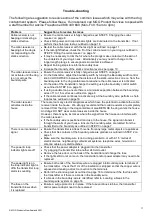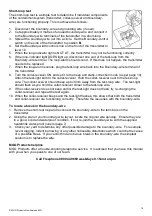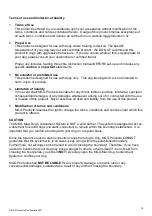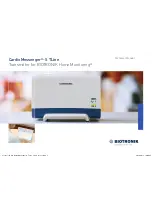
13
© MGG Products New Zealand 2021
6. The collar-receiver strap is adjustable. You may need to
remove excess strap length as follows:
- mark the desired length of the collar-strap with a pen (
9C
)
allowing for growth if your dog is young, or grows a thicker
winter coat
- remove the collar-receiver from your dog. Cut the excess
strapping with scissors. If it is a fabric collar, heat seal the
cut end to avoid fabric fraying
IMPORTANT:
For comfort, safety and effectiveness of the system please ensure the following:
•
Check the fit of the collar-receiver by being able to insert one finger between the collar and
your dog
’s neck
•
The dog should not wear the collar-receiver for more than 12-hours in any one day
•
On a daily basis, examine the contact area of the prongs to the dog’s skin for any signs of skin
irritation, rash or skin sores. If this is observed, discontinue the use of the collar-receiver until
the skin is fully healed. If the condition persists beyond 48 hours, see your veterinarian
•
On a weekly basis, wash the underside skin area of your dog’s neck together with the prongs
using a mild hand soap and water, rinse and dry thoroughly. Check the prongs for tightness
With the collar-receiver correctly fitted, you are ready to start training your dog with the system.
STEP 10:
TRAINING GUIDE
Correct training of your dog is essential to the effectiveness of the Maxi Dog Containment System.
Read this section completely before embarking on training your dog. Remember that the MGG
Maxi Dog Containment System is not a solid barrier. Training is a process as follows:
•
Be patient with your dog
•
Training should be fun, fair, firm and consistent
•
Make training sessions short. Train for a maximum 10 to 15 minutes at a time
•
Do not try to do too much too quickly. Frequent, short sessions work best
•
If your dog shows signs of stress, slow down the training schedule, add additional days of
training or increase the amount of play time with your dog in the dog containment area.
Common stress signals include:
❖
Dog pulling on leash toward the house
❖
Ears tucked
❖
Tail down
❖
Body lowered
❖
Nervous/frantic movement or stiffening of dog
’s body
•
Your dog must be completely comfortable near the boundary training flags at the end of every
training session. Spend at least 5 minutes of “play time” at the completion of each session
within 3 metres of the boundary training flags
•
Remove the collar-receiver after each training session
•
Finish each training session on a positive note with lots of praise and play
•
Be sure to contain your dog by another means during the training period (e.g. pen, tie-out,
leash, etc.)
Important
The aim of training is to teach your dog not to cross the boundary line and remain in the dog
containment area. However, there are times you will want the dog to cross the boundary and
leave the containment area with you. On these occasions, you need to demonstrate to the dog
that it is safe to do so. This is achieved by:






































